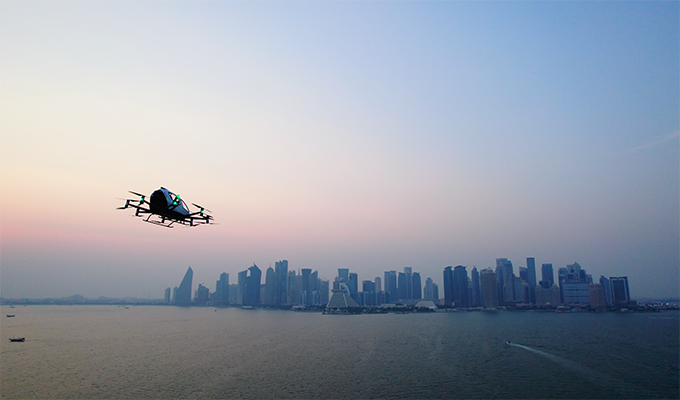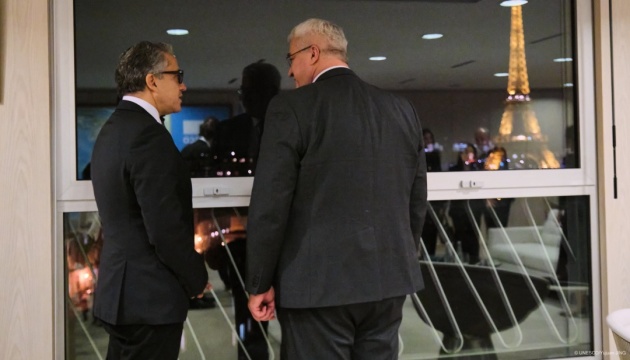EHang EH216-S Conducts First Urban Human-Carrying Pilotless eVTOL Flights in the Middle East, Partnering with Qatar’s Ministry of Transport – EHang

Report on EHang’s Pilotless eVTOL Trial Flights in Doha, Qatar
Executive Summary
On November 17, 2025, EHang, in partnership with Qatar’s Ministry of Transport (MOT), successfully completed a series of trial flights of its EH216-S pilotless electric vertical takeoff and landing (eVTOL) aircraft in Doha. These landmark operations, which included the first urban point-to-point and human-carrying flights of a pilotless eVTOL in the Middle East, demonstrate a significant advancement in Advanced Air Mobility (AAM). The initiative directly supports multiple Sustainable Development Goals (SDGs), particularly those focused on innovation, sustainable cities, climate action, and partnerships, by showcasing a viable model for a safe, efficient, and eco-friendly urban transport system.
Alignment with Sustainable Development Goals (SDGs)
The trial flight program in Doha is a direct contribution to several key United Nations Sustainable Development Goals:
- SDG 9: Industry, Innovation, and Infrastructure: The project represents a leap forward in building resilient infrastructure and fostering innovation. The deployment of AAM technology establishes a new, intelligent transportation system, enhancing Qatar’s technological capacity and industrial innovation.
- SDG 11: Sustainable Cities and Communities: By providing a clean and efficient alternative to ground transport, the EH216-S addresses urban congestion and improves the quality of life. This initiative is a foundational step toward creating inclusive, safe, resilient, and sustainable transport systems for all within urban environments.
- SDG 13: Climate Action: As a fully electric aircraft, the EH216-S produces zero operational emissions, directly contributing to efforts to combat climate change by reducing the carbon footprint of urban transportation, in line with Qatar’s national environmental goals.
- SDG 17: Partnerships for the Goals: The success of the trials is a result of a robust public-private partnership between EHang, the MOT of Qatar, and the Qatar Civil Aviation Authority (QCAA). This collaboration exemplifies the multi-stakeholder approach necessary to achieve sustainable development.
Operational Details and Significance
The trial campaign showcased the operational readiness and commercial potential of the EH216-S for Urban Air Mobility (UAM) applications.
Key Achievements:
- Pioneering Point-to-Point Flights: The flights were conducted between the Port of Doha and the Katara Cultural Village, establishing a proof of concept for an aerial shuttle service connecting key urban hubs.
- Enhanced Efficiency: The eVTOL aircraft transformed a 30-minute car journey into an 8-minute flight, demonstrating a significant reduction in travel time and a solution to ground-level traffic congestion.
- Regulatory Milestone: The flights, executed with authorization from the QCAA, provide a critical reference for civil aviation regulators in the Middle East and globally for the formulation of policies governing pilotless eVTOL operations.
- Alignment with National Strategy: The initiative supports the Qatar National Vision 2030 and the MOT Strategy 2025-2030, which aim to create a smart, sustainable, and integrated transportation system.
Strategic Partnership and Future Outlook
The successful trials pave the way for a strategic alliance to develop and deploy a comprehensive AAM ecosystem in Qatar. The project will proceed in phases, focusing on establishing the necessary technical, operational, and regulatory frameworks.
Future Development Areas:
- Infrastructure Readiness: Development of vertiports and charging infrastructure.
- System Integration: Integration of eVTOL services into Qatar’s existing multimodal transport network.
- Targeted Corridors: Establishment of air taxi routes for airport-to-city shuttles, tourism, and high-traffic zones.
- Regulatory Frameworks: Continued collaboration to define safety, security, and quality standards for commercial AAM operations.
This initiative positions Qatar as a regional leader in adopting smart and sustainable mobility solutions, reinforcing its commitment to achieving the Sustainable Development Goals through technological innovation and strategic partnerships.
1. Which SDGs are addressed or connected to the issues highlighted in the article?
-
SDG 9: Industry, Innovation and Infrastructure
The article focuses on the development and trial of a new, innovative technology (pilotless eVTOL aircraft) and the creation of a new form of infrastructure (Advanced Air Mobility). It highlights building a “smart, resilient transportation system” and upgrading technological capabilities.
-
SDG 11: Sustainable Cities and Communities
The project is explicitly designed for Urban Air Mobility (UAM) to address urban transportation challenges. The article mentions bypassing “ground congestion,” improving “the quality of life,” and creating “sustainable mobility solutions” within the city of Doha.
-
SDG 13: Climate Action
The technology is presented as an “eco-friendly” and “environment-friendly” solution. The article states that the initiative supports national efforts to “reduce carbon emissions” by offering an electric alternative to traditional car journeys.
-
SDG 17: Partnerships for the Goals
The success of the trial flights is attributed to a “close partnership” and “strategic cooperation” between the private technology company (EHang) and governmental bodies in Qatar (Ministry of Transport and the Civil Aviation Authority). This public-private partnership is central to the project’s execution and future deployment.
2. What specific targets under those SDGs can be identified based on the article’s content?
-
SDG 9: Industry, Innovation and Infrastructure
- Target 9.1: Develop quality, reliable, sustainable and resilient infrastructure, including regional and transborder infrastructure, to support economic development and human well-being.
The article discusses the development of an Advanced Air Mobility (AAM) system, which is a new form of sustainable and resilient transportation infrastructure. The plan to integrate “eVTOL systems into Qatar’s multimodal transport strategy” directly supports this target. - Target 9.4: By 2030, upgrade infrastructure and retrofit industries to make them sustainable, with increased resource-use efficiency and greater adoption of clean and environmentally sound technologies and industrial processes.
The EH216-S is described as a “pilotless electric vertical takeoff and landing (eVTOL) aircraft” and an “eco-friendly” solution. Its adoption represents an upgrade to the existing transportation infrastructure with a “clean and environmentally sound” technology.
- Target 9.1: Develop quality, reliable, sustainable and resilient infrastructure, including regional and transborder infrastructure, to support economic development and human well-being.
-
SDG 11: Sustainable Cities and Communities
- Target 11.2: By 2030, provide access to safe, affordable, accessible and sustainable transport systems for all.
The project aims to create a new mode of urban transport (“air taxi corridors”) that is safe, efficient, and sustainable. The article highlights its potential to “bypass ground congestion” and serve as an “aerial shuttle service connecting transport hubs with key urban destinations.” - Target 11.6: By 2030, reduce the adverse per capita environmental impact of cities, including by paying special attention to air quality.
By introducing electric aircraft, the project aims to “reduce carbon emissions” associated with traditional urban transport, thereby contributing to better air quality and reducing the city’s environmental impact.
- Target 11.2: By 2030, provide access to safe, affordable, accessible and sustainable transport systems for all.
-
SDG 13: Climate Action
- Target 13.2: Integrate climate change measures into national policies, strategies and planning.
The article explicitly states that this initiative is in line with “Qatar National Vision 2030” and the “MOT Strategy 2025-2030,” which aim to create a sustainable transportation system and support “national efforts to reduce carbon emissions.” This demonstrates the integration of climate-friendly solutions into national strategy.
- Target 13.2: Integrate climate change measures into national policies, strategies and planning.
-
SDG 17: Partnerships for the Goals
- Target 17.17: Encourage and promote effective public, public-private and civil society partnerships, building on the experience and resourcing strategies of partnerships.
The entire project is a result of a “strategic alliance” and “close collaboration between EHang, the MOT of Qatar, and the QCAA.” This public-private partnership is presented as the key to ensuring the “regulatory, safety, and operational readiness of this project.”
- Target 17.17: Encourage and promote effective public, public-private and civil society partnerships, building on the experience and resourcing strategies of partnerships.
3. Are there any indicators mentioned or implied in the article that can be used to measure progress towards the identified targets?
-
Reduction in Travel Time
The article provides a specific metric: transforming a “30-minute car journey into a sustainable, 8-minute flight.” This directly measures the efficiency and effectiveness of the new transport system (Target 11.2).
-
Successful Completion of Trial Flights
The “successful completion of a landmark series of trial airtaxi flights, including point-to-point and human-carrying flights” serves as a key performance indicator of technological maturity and operational readiness, demonstrating progress in developing new, reliable infrastructure (Target 9.1).
-
Establishment of Public-Private Partnerships
The formation of the “strategic alliance between EHang and the MOT of Qatar” is itself an indicator of progress towards Target 17.17. The successful collaboration on these trial flights demonstrates the effectiveness of the partnership.
-
Reduction in Carbon Emissions
While not quantified, the goal to “reduce carbon emissions” is a central theme. The shift from fossil-fuel-based car journeys to electric flights implies a measurable reduction in CO2 per trip, which can be calculated and used as an indicator for progress towards Targets 11.6 and 13.2.
4. SDGs, Targets, and Indicators Analysis
| SDGs | Targets | Indicators |
|---|---|---|
| SDG 9: Industry, Innovation and Infrastructure | 9.1: Develop quality, reliable, sustainable and resilient infrastructure. 9.4: Upgrade infrastructure… with greater adoption of clean and environmentally sound technologies. |
Successful completion of point-to-point and human-carrying trial flights; Deployment of pilotless eVTOL aircraft as a new mode of transport. |
| SDG 11: Sustainable Cities and Communities | 11.2: Provide access to safe, affordable, accessible and sustainable transport systems for all. 11.6: Reduce the adverse per capita environmental impact of cities. |
Reduction of a 30-minute car journey to an 8-minute flight; Establishment of aerial shuttle services and air taxi corridors to bypass ground congestion. |
| SDG 13: Climate Action | 13.2: Integrate climate change measures into national policies, strategies and planning. | Adoption of electric aircraft to support national goals of reducing carbon emissions; Alignment of the project with Qatar National Vision 2030. |
| SDG 17: Partnerships for the Goals | 17.17: Encourage and promote effective public, public-private and civil society partnerships. | Establishment and successful execution of a strategic alliance between EHang (private sector) and Qatar’s Ministry of Transport & Civil Aviation Authority (public sector). |
Source: ehang.com
What is Your Reaction?
 Like
0
Like
0
 Dislike
0
Dislike
0
 Love
0
Love
0
 Funny
0
Funny
0
 Angry
0
Angry
0
 Sad
0
Sad
0
 Wow
0
Wow
0
















































:focal(1500,1000)/https://media.globalcitizen.org/a6/9a/a69a4720-d8a1-4715-b596-18738d03c05c/rotary_polio_hero_image.jpg?#)







/countries/sri-lanka/photo-credit---dmc-sri-lanka.tmb-1200v.jpg?sfvrsn=dc298bcc_1#)


















